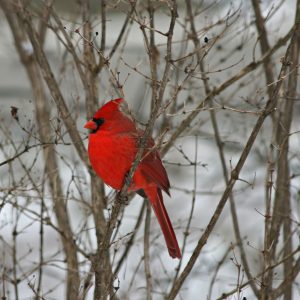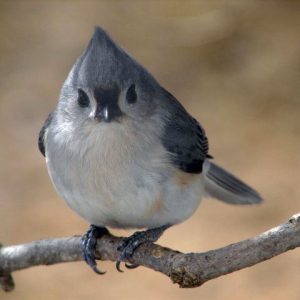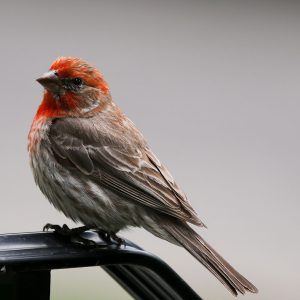
Few songs are as cheerful as “cheer, cheer, cheer” of a Northern Cardinal during a Maine winter. (Photo: Terry Sprague)
The temperature was skin-numbing. Even the slightest ripple of wind cut our lungs like fire.
And yet, the birds sang.
Sure, the sun was shining. The sky was brilliant blue. But the temps were so freakily cold that our little dog Loki, despite double layers of sweaters, would get just a short walk, for the safety of us all on such a day as this.
As we stepped cautiously out from the warmth of our house, there came the “cheer, cheer, cheer” of a Northern Cardinal. Just up the block, a Tufted Titmouse song rang out as well: “peter, peter, peter.”
In the days that followed, the temperatures moderated just enough for us to extend our dog walks around the neighborhood by a few blocks. As we plodded on, we heard even more singing birds—the long warbles of House Finches. Black-capped Chickadees offered their plaintive “FEE-bee” songs. We even heard the “TEA-kettle, TEA-kettle” of our local Carolina Wren.
Our spirits soared. Hearing such avian music in the cold months of winter always does a soul good.
Why?
For us (and very likely for most people who are paying attention), bird songs on a frigid day are an affirmation of the coming spring. They remind us that soon, trees will leaf out, butterflies and bumblebees will return to the blossoms of colorful flowers. And birds that have spent the winter in southern regions will again return to the Maine landscape, build nests, mate, and raise young. Through much of that time, they will sing—anthems to the rejuvenation of life.

A Tufted Titmouse gave their “peter, peter, peter,” warming the spirit on a cold winter day. (Photo: Beth Comeau)
Embracing signs of spring doesn’t mean we don’t relish the beauty and challenge of winter. For birders, winter brings many birds we can’t see any other time—Harlequin Ducks, Snowy Owls, Iceland Gulls, not to mention a Steller’s Sea-eagle!
Still, humans seem to have built into our DNA a yearning for the longer days and signs of spring that come as we pass through the winter solstice. It makes sense. Think back to the hardships that people living in northern climes endured during the winter months, when cold and snow cover made the challenges of finding food a struggle to fulfill a basic human need.
Birds, too, must find ways to persist in the hard conditions of winter. Their songs this time of year may give us a vision of spring to come, but what do they do for the birds themselves?
The scientific mind would note that these bird songs are expressions of territoriality to ensure that others of the same species will stay out and respect the turf of the singer. And that is undoubtedly true.

House Finches can often be heard giving their long chattery warbles in winter. (Photo: David Small)
But is it also possible that there is some universality in how living things on this planet proclaim and find hope in the truth of the return of light and warmth after the cold northern winter?
Recently published research in the scientific journal Nature has shown that there appears to be a universal mathematical law that is common to both human music and the songs of birds and other animals. The researchers suggest that this is because evolution has shaped the brains of all animals that make and listen to sounds to be sensitized to the patterns embodied by certain structural components of natural sounds.
This heady research used bird sound recordings from the Macaulay Library at the Cornell Laboratory of Ornithology for much of the analyses, including dozens of recordings by our friends and colleagues as well as many from historical figures in ornithology like Arthur Allen (founder of the Cornell Lab of Ornithology), Peter Paul Kellogg, William Gunn, and Ted Parker, among others. Somehow it seems especially fitting that a potpourri of bird sound recordings made from the 1950s to today, and from hundreds of people, was used to help shed light on such a core understanding of the shared experience of animals and sounds.
Maybe a bird song heard on a cold winter day that brings a spark of joy and hope is rooted far deeper than we know. Maybe, for birds, too, a song is more than it seems.
—Jeff and Allison Wells










Leave a Reply